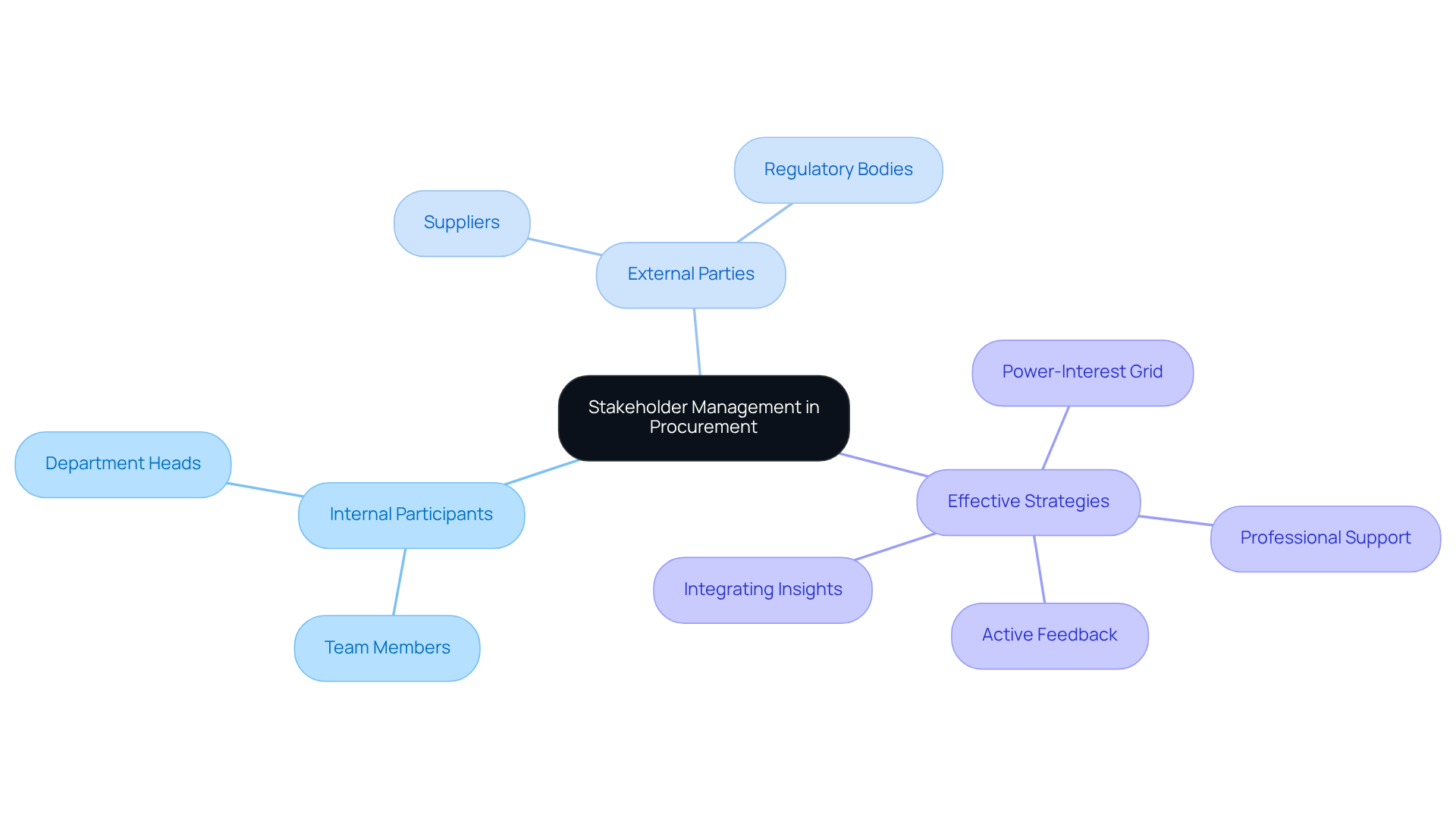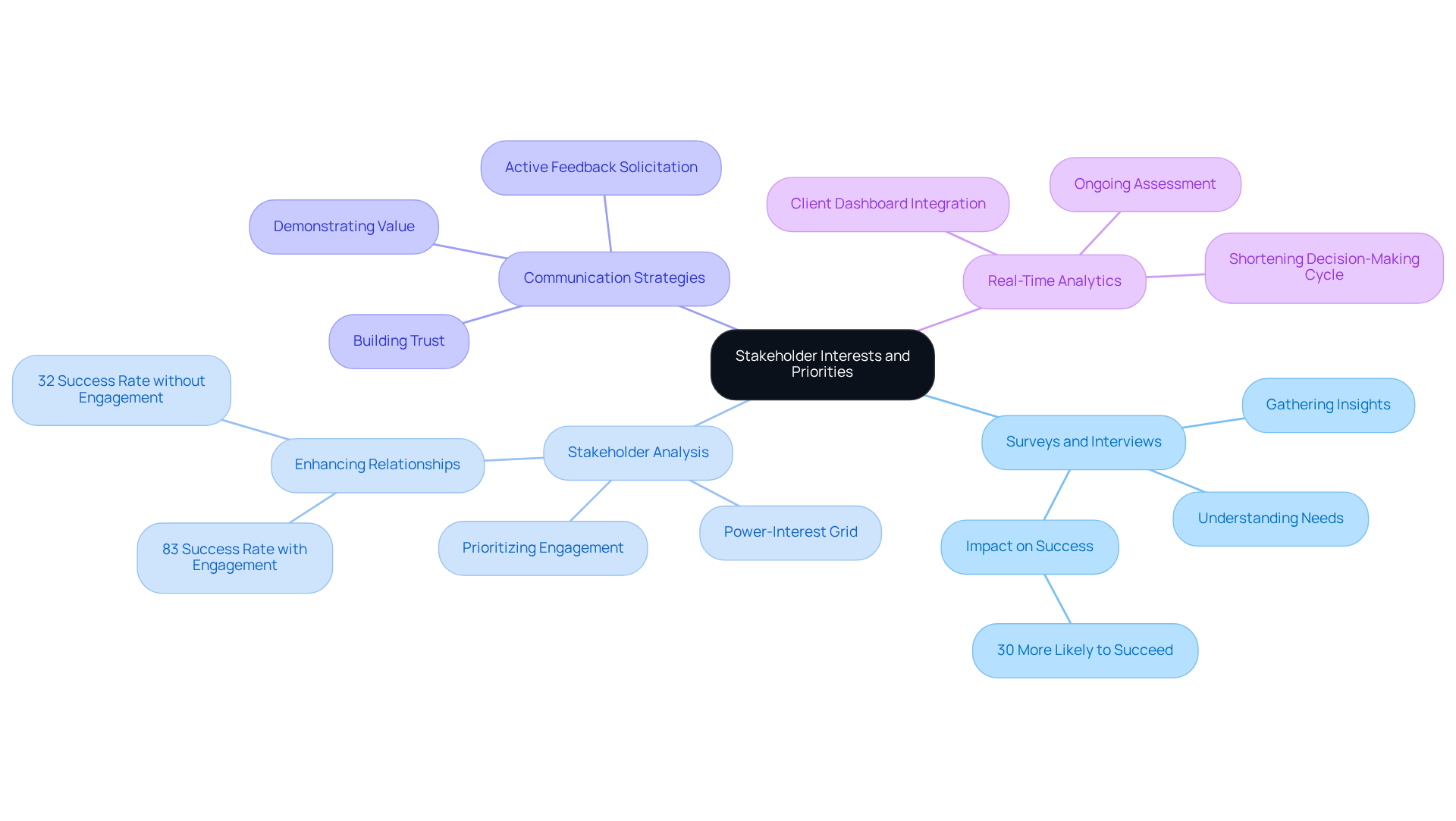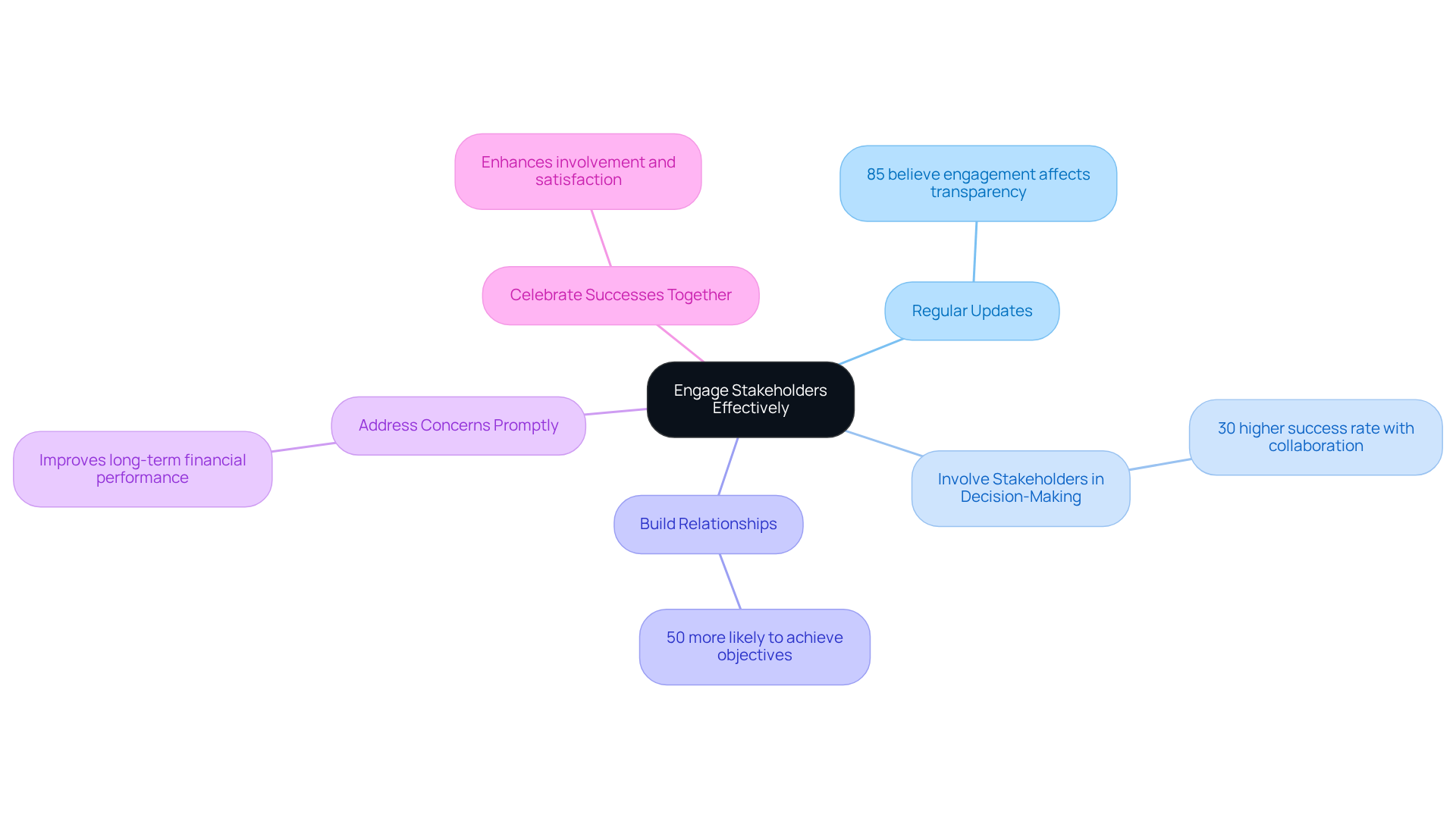Overview
The article presents a comprehensive approach to mastering stakeholder management in procurement, underscoring the critical nature of identifying, analyzing, and engaging both internal and external stakeholders. It elaborates on effective strategies, including:
- The utilization of the Power-Interest Grid
- The creation of a communication plan
- The involvement of stakeholders in decision-making processes
These strategies not only enhance collaboration but also significantly increase the likelihood of achieving procurement goals.
Introduction
Mastering stakeholder management in procurement is not just important; it is a critical factor that can determine the success or failure of purchasing initiatives. By effectively identifying, analyzing, and engaging both internal and external stakeholders, organizations can enhance collaboration and drive project outcomes.
However, many procurement professionals grapple with the complexities of stakeholder dynamics, which often leads to missed opportunities and inefficiencies.
How can organizations navigate these challenges and create a robust framework for stakeholder engagement that not only meets procurement goals but also fosters lasting partnerships?
The answer lies in a strategic approach that prioritizes stakeholder engagement as a core component of procurement success.
Define Stakeholder Management in Procurement
A structured approach to identifying, analyzing, and engaging individuals or groups impacted by purchasing activities is essential for effective stakeholder management in procurement. This encompasses both internal participants—such as team members and department heads—and external parties, including suppliers and regulatory bodies. Efficient stakeholder management in procurement is crucial for aligning all involved parties with acquisition goals, fostering teamwork, and minimizing disputes. Notably, organizations with robust participant strategies are 40% more likely to complete projects on schedule and within budget. Current trends indicate a growing emphasis on transparency and sustainability; indeed, 85% of companies face challenges in achieving sustainability objectives due to difficulties in locating suppliers with sustainable practices.
Effective strategies for stakeholder management in procurement involve:
- Utilizing the Power-Interest Grid to classify interested parties
- Securing professional support
- Soliciting active feedback
- Integrating insights from these individuals into decision-making processes
By concentrating on these elements, organizations can enhance purchasing efficiency and achieve strategic objectives.

Identify Key Stakeholders
Recognizing essential participants is vital for favorable results in stakeholder management in procurement. Begin by compiling a comprehensive list of potential stakeholders, categorizing them into two main groups:
- Internal Stakeholders: This group includes procurement team members, finance department personnel, project managers, and executive leadership. Their insights and choices greatly impact purchasing strategies.
- External Stakeholders: This encompasses suppliers, customers, regulatory agencies, and industry associations. Each of these parties plays a vital role in stakeholder management in procurement and can influence the overall success of the project.
To effectively classify interested parties, utilize tools such as mapping of participants and influence-interest grids. As noted, 'network analysis is essential for mapping interested parties.' These methods illustrate the degree of impact and interest each participant has in purchasing activities. Involving interested parties early in the purchasing cycle is crucial for stakeholder management in procurement; it clarifies their roles and expectations, ensuring that their needs are met throughout the process. This proactive approach not only fosters collaboration but also enhances the likelihood of achieving procurement goals. In fact, companies that truly interact with interested parties are 50% more likely to achieve their significant objectives. Moreover, involving key employees in participant engagement makes transformations four times more likely to succeed.

Analyze Stakeholder Interests and Priorities
Identifying crucial parties is a key aspect of stakeholder management in procurement, as it sets the stage for examining their interests and priorities. This can be achieved through several effective methods:
- Surveys and Interviews: Conducting one-on-one discussions or surveys is essential for gathering insights into stakeholders' expectations, concerns, and objectives. Research indicates that companies engaging with interested parties are 30% more likely to succeed with new products, underscoring the importance of understanding their needs.
- Stakeholder Analysis: Utilizing tools such as the power-interest grid enables purchasing professionals to illustrate the influence and interest levels of involved parties. This method aids in prioritizing engagement activities, ensuring that the most significant participants are addressed first.
Understanding these dynamics allows purchasing specialists to tailor their communication strategies effectively. By actively seeking input and demonstrating attentiveness, involved parties feel acknowledged and valued. This proactive approach not only fosters stronger relationships but also significantly enhances stakeholder management in procurement outcomes. In fact, initiatives with strong participant involvement succeed 83% of the time, whereas those lacking emphasis on participant relationships succeed only 32% of the time. Furthermore, integrating real-time business analytics via a client dashboard into the engagement process facilitates ongoing assessment of participant sentiments and project performance, enabling teams to make informed decisions swiftly and adjust strategies as necessary to bolster strengths and address weaknesses. The insights gained also shorten the decision-making cycle, ensuring that actions can be taken promptly to safeguard business interests.

Create a Stakeholder Communication Plan
To create an effective stakeholder communication plan, consider the following steps:
- Identify Communication Objectives: Clearly define your goals, such as keeping interested parties informed about procurement updates or soliciting their feedback.
- Identify Communication Methods: Choose appropriate avenues for interaction, including emails, meetings, newsletters, or collaborative platforms, to ensure messages reach involved parties effectively.
- Establish Frequency and Timing: Determine the ideal frequency and timing for interactions to sustain participant engagement without leading to information overload.
- Tailor Messages: Personalize your messages to align with the interests and priorities of various parties, ensuring clarity and relevance. As PMI states, "The key to effective interaction with interested parties is to understand the needs and expectations of each group and tailor messaging accordingly."
- Feedback Mechanism: Establish a strong system for interested parties to offer input, enabling ongoing enhancement in your messaging strategies.
Efficient interaction is essential in procurement. Research shows that initiatives with robust participant plans succeed 83% of the time, compared to only 32% for those lacking. Furthermore, 70% of initiatives that did not achieve their goals mentioned inadequate communication with involved parties as a significant factor. By prioritizing these steps, organizations can improve participant engagement and drive project success.

Engage Stakeholders Effectively
To effectively engage stakeholders in procurement, organizations should implement the following strategies:
- Regular Updates: Keeping stakeholders informed about procurement progress and any changes that may affect them is crucial. Consistent communication greatly improves participant satisfaction; in fact, 85% of individuals believe that engagement affects their view of organizational transparency.
- Involve stakeholders in decision-making: Encouraging participation in discussions and decisions is essential for effective stakeholder management in procurement, fostering a sense of ownership and commitment. Organizations that actively implement stakeholder management in procurement are 30% more likely to succeed with new products, underscoring the importance of collaborative decision-making.
- Build Relationships: Taking the time to understand interested parties personally can enhance trust and collaboration. Involved parties are 50% more likely to attain their significant objectives, illustrating the significance of robust connections.
- Address Concerns Promptly: Being responsive to inquiries and concerns from interested parties demonstrates that their input is valued. This responsiveness can lead to improved long-term financial performance and operational efficiency.
- Celebrate Successes Together: Acknowledging and celebrating milestones achieved through collaborative efforts reinforces positive relationships and shared goals. Celebrating successes enhances involvement from interested parties, resulting in a more dedicated and content group.
By implementing these strategies, organizations can improve stakeholder management in procurement, ultimately driving better project outcomes and fostering a culture of collaboration.

Conclusion
Mastering stakeholder management in procurement is essential for aligning diverse interests and achieving strategic objectives. By effectively identifying, analyzing, and engaging both internal and external stakeholders, organizations can foster collaboration, minimize disputes, and enhance project outcomes. The structured approach outlined in this guide emphasizes the importance of understanding stakeholder dynamics and implementing targeted strategies to ensure all voices are heard and valued.
Throughout the article, key strategies for stakeholder management in procurement have been discussed, including:
- The use of tools like the Power-Interest Grid
- The significance of creating a robust communication plan
- The benefits of actively engaging stakeholders in decision-making processes
These steps not only improve the likelihood of project success but also contribute to a culture of transparency and collaboration within organizations. By prioritizing stakeholder engagement, companies can significantly enhance their procurement efficiency and achieve their goals more effectively.
Ultimately, the success of procurement initiatives hinges on the ability to build strong relationships with stakeholders. This involves regular communication, addressing concerns promptly, and celebrating shared achievements. As organizations navigate the complexities of procurement, embracing these best practices will not only lead to better project outcomes but also cultivate a more engaged and committed stakeholder community. Taking proactive steps towards mastering stakeholder management in procurement is not just beneficial—it's essential for long-term success.
Frequently Asked Questions
What is stakeholder management in procurement?
Stakeholder management in procurement is a structured approach to identifying, analyzing, and engaging individuals or groups affected by purchasing activities. It includes both internal participants, like team members and department heads, and external parties, such as suppliers and regulatory bodies.
Why is effective stakeholder management important in procurement?
Effective stakeholder management is crucial for aligning all parties with acquisition goals, fostering teamwork, and minimizing disputes. Organizations with strong stakeholder strategies are 40% more likely to complete projects on schedule and within budget.
What current trends are influencing stakeholder management in procurement?
There is a growing emphasis on transparency and sustainability in procurement. However, 85% of companies face challenges in achieving sustainability objectives due to difficulties in finding suppliers with sustainable practices.
What strategies can enhance stakeholder management in procurement?
Effective strategies include utilizing the Power-Interest Grid to classify stakeholders, securing professional support, soliciting active feedback, and integrating insights from stakeholders into decision-making processes.
Who are considered key stakeholders in procurement?
Key stakeholders can be categorized into two main groups: Internal Stakeholders (such as procurement team members, finance personnel, project managers, and executive leadership) and External Stakeholders (including suppliers, customers, regulatory agencies, and industry associations).
How can organizations identify and classify stakeholders effectively?
Organizations can identify and classify stakeholders by compiling a comprehensive list and using tools like participant mapping and influence-interest grids to illustrate the degree of impact and interest of each participant in purchasing activities.
What is the benefit of involving stakeholders early in the purchasing cycle?
Involving stakeholders early clarifies their roles and expectations, ensuring their needs are met throughout the process. This proactive approach fosters collaboration and enhances the likelihood of achieving procurement goals.
What impact does stakeholder engagement have on achieving procurement objectives?
Companies that actively engage with stakeholders are 50% more likely to achieve their significant objectives. Additionally, involving key employees in stakeholder engagement increases the likelihood of successful transformations by four times.




